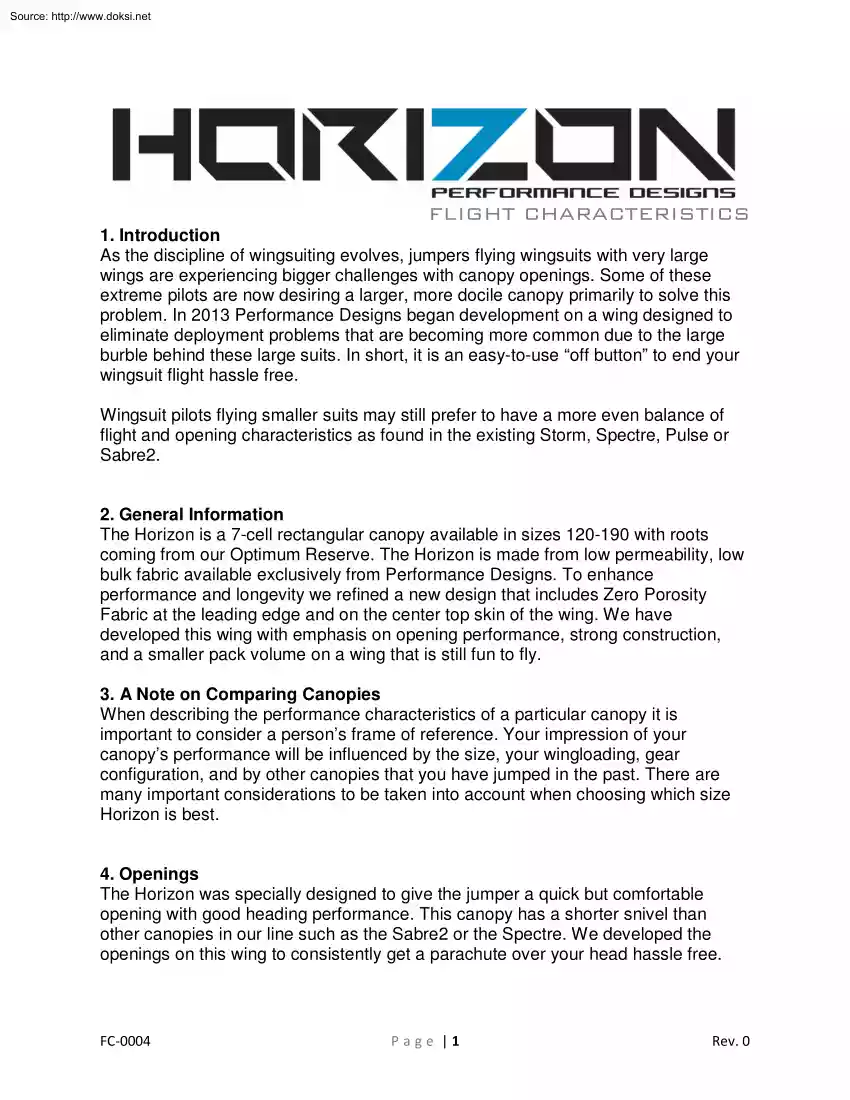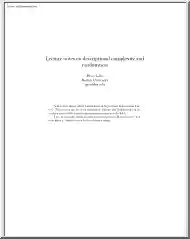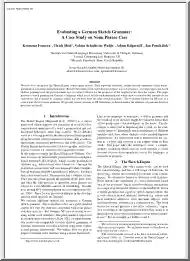Please log in to read this in our online viewer!

Please log in to read this in our online viewer!
No comments yet. You can be the first!
What did others read after this?
Content extract
Source: http://www.doksinet FLIGHT CHARACTERISTICS 1. Introduction As the discipline of wingsuiting evolves, jumpers flying wingsuits with very large wings are experiencing bigger challenges with canopy openings. Some of these extreme pilots are now desiring a larger, more docile canopy primarily to solve this problem. In 2013 Performance Designs began development on a wing designed to eliminate deployment problems that are becoming more common due to the large burble behind these large suits. In short, it is an easy-to-use “off button” to end your wingsuit flight hassle free. Wingsuit pilots flying smaller suits may still prefer to have a more even balance of flight and opening characteristics as found in the existing Storm, Spectre, Pulse or Sabre2. 2. General Information The Horizon is a 7-cell rectangular canopy available in sizes 120-190 with roots coming from our Optimum Reserve. The Horizon is made from low permeability, low bulk fabric available exclusively from
Performance Designs. To enhance performance and longevity we refined a new design that includes Zero Porosity Fabric at the leading edge and on the center top skin of the wing. We have developed this wing with emphasis on opening performance, strong construction, and a smaller pack volume on a wing that is still fun to fly. 3. A Note on Comparing Canopies When describing the performance characteristics of a particular canopy it is important to consider a person’s frame of reference. Your impression of your canopy’s performance will be influenced by the size, your wingloading, gear configuration, and by other canopies that you have jumped in the past. There are many important considerations to be taken into account when choosing which size Horizon is best. 4. Openings The Horizon was specially designed to give the jumper a quick but comfortable opening with good heading performance. This canopy has a shorter snivel than other canopies in our line such as the Sabre2 or the Spectre.
We developed the openings on this wing to consistently get a parachute over your head hassle free. FC-0004 P age |1 Rev. 0 Source: http://www.doksinet We have found that slowing down before deployment results in softer openings, however, this canopy has excellent performance with a variety of deployment techniques. During the development of the Horizon, careful attention was placed on minimizing opening forces for safety as well as stability. Occasionally, less than perfect body position while deploying with a wingsuit may result in line twists. The Horizon is tolerant of occasional line twists, flying flat and level, and giving the jumper time to access the controls on their canopy after unzipping their suit. 5. General Flight Characteristics Glide: The Horizon will not glide as far as some of our flatter trimmed wings, such as the Pulse, but may out glide some canopies designed to have a longer recovery arc. The glide of the Horizon is comparable to the Spectre. Although this
canopy is not designed to have a very flat glide, the performance of the Horizon in rears and in brakes make it an easy canopy to fly back home. Turns: The Horizon has an agile response to all control inputs and the canopy responds quickly to pilot input. The pilot will have good feedback from the canopy throughout the entire control range. Keep in mind that if you are accustomed to smaller 9-cell mains, the Horizon may require considerably more control deflection to achieve a quick snappy response. Front risers are light with a slow build, making this canopy easy to maneuver around the sky quickly if desired. The rear risers also have light pressure and a wide range, stalling fairly deep. The Horizon feels very similar in toggle turns to our Optimum reserve. Like most 7-cell canopies, the Horizon is quite dynamic when responding to braked flight turning inputs. This makes it a great canopy to conserve altitude with on your flight back home. Control Range: The Horizon has a fairly long
control range with excellent slow flight characteristics. The stall point is very deep for most jumpers. It may be possible to fly at full arm extension for a few seconds prior to the wing beginning to stall. Of course the exact stall point of any canopy depends on the canopy size, riser and arm length, and other factors such as the speed of the input given to the canopy. The stall of the Horizon is predictable on both toggles and rears. Recovery from an induced stall is quick and clean. As always, checking the stall point should be done with plenty of altitude to spare. Recovery Arc: The Horizon has a medium range for recovery arc. This means it will not dive quite as long as a canopy like the Sabre2, but it will dive longer than canopies with a short recovery arc such as a Pulse in the same size. It is important to remember that a canopy’s recovery arc is also affected by wing loading: a higher wing loading generally causes the recovery arc to become longer. Conversely, since you
are FC-0004 P age |2 Rev. 0 Source: http://www.doksinet likely jumping a larger size Horizon than what is currently in your container, the recovery arc may feel a bit shorter than what you are accustomed to. Landings: The Horizon continues to uphold the landing performance that Performance Designs customers have come to expect. As soon as you engage the toggles the canopy will respond immediately to proper flare input, providing ample feedback to the jumper throughout the entire landing flare. It is easy to predict where the “sweet spot” in the flare will be, causing the canopy to plane out easily for a nice shutdown. The long control range and powerful response makes this canopy easy to land well with timing of the input being less critical than other canopies of a similar type. Although the Horizon has proven to have good landing performance both on straight-in approaches as well as high performance approaches, these great landings are not automatic. You must have the skill
and technique that is appropriate for the size of the Horizon wing that you have selected. Any small canopy will have a high descent rate on final, so flaring must be timed well. 6. Sizing The Horizon is a Low Bulk 7-cell canopy made exclusively for wingsuit pilots. It is imperative that you understand how the performance of the Horizon is different from other parachute systems commonly used in wingsuiting. Proper deployment, flight, landing, and packing procedures for this canopy must be followed at all times. There are many factors to consider when deciding which size Horizon is the best for you. To summarize this process in three words, BIGGER is better. The fabrics utilized in the Horizon’s construction are part of what makes it unique. We know you will love its light weight and small pack volume in addition to the performance of the wing. However, the very things that make this canopy different also demand more experienced canopy pilots to get consistently comfortable landings
(when compared to an all ZP canopy in a similar size and design). For this reason, we recommend that you have at least 50 jumps on a canopy (landing accurately and comfortably on your feet) that is approximately two (2) sizes SMALLER than the Horizon you plan to use for wingsuiting. The components that you will use to deploy the wing, your wing suit, the density altitude where you jump, and your canopy piloting experience all play a role as well. It is always advisable to consult a certified wingsuit coach/ instructor when selecting a canopy to optimize your wingsuiting experience. For more information on our recommendations for components to optimize your Horizon experience, please reference the Horizon Packing Manual located on our website www.performancedesignscom Your wing loading is a critical factor in the performance of your Horizon canopy. Extensive R&D and careful consideration have gone into our wing loading FC-0004 P age |3 Rev. 0 Source: http://www.doksinet
recommendations. Our testing has shown that jumping the canopy outside of our recommendations can affect the canopy’s opening, flight, and landing performance as well as the longevity of the wing itself. The best way to find out how any canopy performs is to jump that specific size and type of canopy. Performance Designs has demo Horizons available, allowing you to find out how a certain size will fly and land before you buy it. We encourage you to take advantage of this opportunity to “fly before you buy.” For More Information Jumpers in the USA contact us by phone at (386) 738-2224 e-mail demos@performancedesigns.com European skydivers contact one of our European Demo Centers e-mail EUdemos@performancedesigns.com Demo information is also available on our web site www.performancedesignscom FC-0004 P age |4 Rev. 0 Source: http://www.doksinet A NOTE ABOUT RESERVES The Horizon brings us the amazing capability to pack a canopy that is significantly larger than what we could
normally pack into our containers. It is this ability to upsize our mains that make the Horizon the perfect tool to optimize your wingsuiting experience. It does not give us the ability to change the size of the reserve on our back however. Consideration of the reserve that is currently in your container and its compatibility with the wingsuit you are flying is something that should never be overlooked. If your reserve is more than 15% smaller than your main, there will probably be dramatic differences not only on the opening characteristics but the flight and landing as well. Even if you are a highly experienced skydiver you need to be cautious if you plan to jump with a small or highly loaded reserve. Adding a wingsuit to this equation can create potential complications that should not be taken lightly when selecting your equipment to give you the best wingsuiting experience. FC-0004 P age |5 Rev. 0
Performance Designs. To enhance performance and longevity we refined a new design that includes Zero Porosity Fabric at the leading edge and on the center top skin of the wing. We have developed this wing with emphasis on opening performance, strong construction, and a smaller pack volume on a wing that is still fun to fly. 3. A Note on Comparing Canopies When describing the performance characteristics of a particular canopy it is important to consider a person’s frame of reference. Your impression of your canopy’s performance will be influenced by the size, your wingloading, gear configuration, and by other canopies that you have jumped in the past. There are many important considerations to be taken into account when choosing which size Horizon is best. 4. Openings The Horizon was specially designed to give the jumper a quick but comfortable opening with good heading performance. This canopy has a shorter snivel than other canopies in our line such as the Sabre2 or the Spectre.
We developed the openings on this wing to consistently get a parachute over your head hassle free. FC-0004 P age |1 Rev. 0 Source: http://www.doksinet We have found that slowing down before deployment results in softer openings, however, this canopy has excellent performance with a variety of deployment techniques. During the development of the Horizon, careful attention was placed on minimizing opening forces for safety as well as stability. Occasionally, less than perfect body position while deploying with a wingsuit may result in line twists. The Horizon is tolerant of occasional line twists, flying flat and level, and giving the jumper time to access the controls on their canopy after unzipping their suit. 5. General Flight Characteristics Glide: The Horizon will not glide as far as some of our flatter trimmed wings, such as the Pulse, but may out glide some canopies designed to have a longer recovery arc. The glide of the Horizon is comparable to the Spectre. Although this
canopy is not designed to have a very flat glide, the performance of the Horizon in rears and in brakes make it an easy canopy to fly back home. Turns: The Horizon has an agile response to all control inputs and the canopy responds quickly to pilot input. The pilot will have good feedback from the canopy throughout the entire control range. Keep in mind that if you are accustomed to smaller 9-cell mains, the Horizon may require considerably more control deflection to achieve a quick snappy response. Front risers are light with a slow build, making this canopy easy to maneuver around the sky quickly if desired. The rear risers also have light pressure and a wide range, stalling fairly deep. The Horizon feels very similar in toggle turns to our Optimum reserve. Like most 7-cell canopies, the Horizon is quite dynamic when responding to braked flight turning inputs. This makes it a great canopy to conserve altitude with on your flight back home. Control Range: The Horizon has a fairly long
control range with excellent slow flight characteristics. The stall point is very deep for most jumpers. It may be possible to fly at full arm extension for a few seconds prior to the wing beginning to stall. Of course the exact stall point of any canopy depends on the canopy size, riser and arm length, and other factors such as the speed of the input given to the canopy. The stall of the Horizon is predictable on both toggles and rears. Recovery from an induced stall is quick and clean. As always, checking the stall point should be done with plenty of altitude to spare. Recovery Arc: The Horizon has a medium range for recovery arc. This means it will not dive quite as long as a canopy like the Sabre2, but it will dive longer than canopies with a short recovery arc such as a Pulse in the same size. It is important to remember that a canopy’s recovery arc is also affected by wing loading: a higher wing loading generally causes the recovery arc to become longer. Conversely, since you
are FC-0004 P age |2 Rev. 0 Source: http://www.doksinet likely jumping a larger size Horizon than what is currently in your container, the recovery arc may feel a bit shorter than what you are accustomed to. Landings: The Horizon continues to uphold the landing performance that Performance Designs customers have come to expect. As soon as you engage the toggles the canopy will respond immediately to proper flare input, providing ample feedback to the jumper throughout the entire landing flare. It is easy to predict where the “sweet spot” in the flare will be, causing the canopy to plane out easily for a nice shutdown. The long control range and powerful response makes this canopy easy to land well with timing of the input being less critical than other canopies of a similar type. Although the Horizon has proven to have good landing performance both on straight-in approaches as well as high performance approaches, these great landings are not automatic. You must have the skill
and technique that is appropriate for the size of the Horizon wing that you have selected. Any small canopy will have a high descent rate on final, so flaring must be timed well. 6. Sizing The Horizon is a Low Bulk 7-cell canopy made exclusively for wingsuit pilots. It is imperative that you understand how the performance of the Horizon is different from other parachute systems commonly used in wingsuiting. Proper deployment, flight, landing, and packing procedures for this canopy must be followed at all times. There are many factors to consider when deciding which size Horizon is the best for you. To summarize this process in three words, BIGGER is better. The fabrics utilized in the Horizon’s construction are part of what makes it unique. We know you will love its light weight and small pack volume in addition to the performance of the wing. However, the very things that make this canopy different also demand more experienced canopy pilots to get consistently comfortable landings
(when compared to an all ZP canopy in a similar size and design). For this reason, we recommend that you have at least 50 jumps on a canopy (landing accurately and comfortably on your feet) that is approximately two (2) sizes SMALLER than the Horizon you plan to use for wingsuiting. The components that you will use to deploy the wing, your wing suit, the density altitude where you jump, and your canopy piloting experience all play a role as well. It is always advisable to consult a certified wingsuit coach/ instructor when selecting a canopy to optimize your wingsuiting experience. For more information on our recommendations for components to optimize your Horizon experience, please reference the Horizon Packing Manual located on our website www.performancedesignscom Your wing loading is a critical factor in the performance of your Horizon canopy. Extensive R&D and careful consideration have gone into our wing loading FC-0004 P age |3 Rev. 0 Source: http://www.doksinet
recommendations. Our testing has shown that jumping the canopy outside of our recommendations can affect the canopy’s opening, flight, and landing performance as well as the longevity of the wing itself. The best way to find out how any canopy performs is to jump that specific size and type of canopy. Performance Designs has demo Horizons available, allowing you to find out how a certain size will fly and land before you buy it. We encourage you to take advantage of this opportunity to “fly before you buy.” For More Information Jumpers in the USA contact us by phone at (386) 738-2224 e-mail demos@performancedesigns.com European skydivers contact one of our European Demo Centers e-mail EUdemos@performancedesigns.com Demo information is also available on our web site www.performancedesignscom FC-0004 P age |4 Rev. 0 Source: http://www.doksinet A NOTE ABOUT RESERVES The Horizon brings us the amazing capability to pack a canopy that is significantly larger than what we could
normally pack into our containers. It is this ability to upsize our mains that make the Horizon the perfect tool to optimize your wingsuiting experience. It does not give us the ability to change the size of the reserve on our back however. Consideration of the reserve that is currently in your container and its compatibility with the wingsuit you are flying is something that should never be overlooked. If your reserve is more than 15% smaller than your main, there will probably be dramatic differences not only on the opening characteristics but the flight and landing as well. Even if you are a highly experienced skydiver you need to be cautious if you plan to jump with a small or highly loaded reserve. Adding a wingsuit to this equation can create potential complications that should not be taken lightly when selecting your equipment to give you the best wingsuiting experience. FC-0004 P age |5 Rev. 0




 Just like you draw up a plan when you’re going to war, building a house, or even going on vacation, you need to draw up a plan for your business. This tutorial will help you to clearly see where you are and make it possible to understand where you’re going.
Just like you draw up a plan when you’re going to war, building a house, or even going on vacation, you need to draw up a plan for your business. This tutorial will help you to clearly see where you are and make it possible to understand where you’re going.